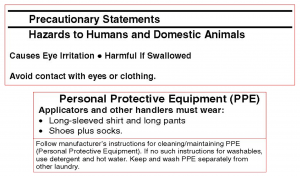Many folks may not realize it at first, but everyone is using pesticides. Have you recently used a mold or mildew removal cleaner in your bathroom? Do you apply flea & tick powder to your pet? It is a misconception that only farmers, ranchers and lawn and garden enthusiasts are pesticide users. So, let’s all keep safety in mind, as any of these household and outdoor chemicals can be dangerous.

Pesticides include a wide range of products that either kill or repel pests. These pests can be insects, nuisance animals, weeds, plant pathogens, molds and other undesirables. Are pesticides necessary? Maybe not. Pesticides should be considered as a last resort. Using an integrated pest management (IPM) approach is an environmentally safe, and often, economical way to reduce pests. Usually, there are four steps involved in IPM, starting with the practice with the least environmental impact, until a solution to the pest problem has been found. For example, say that you are having issues with aphids in your garden. The IPM approach may begin with cultural measures (ex. avoiding high nitrogen fertilizer as it promotes lush growth that creates a favorable environment for aphids). This may be followed by mechanical measures (ex. use of insect netting) and if problem still exists, biological measures (ex. release of parasitic wasps). As stated earlier, the last resort would be chemical measures (ex. applying pesticide). There are varying IPM strategies for different pests. Please visit the UF/IFAS IPM website for more information: http://ipm.ifas.ufl.edu/
When pesticide usage is necessary, it’s important to select the right chemical(s). Once the pest has been identified, check pesticide labels under the section “pests controlled”. Never assume a pesticide will control a pest not listed under this section. Often, there are numerous products that list a common pest. Always consider five factors when determining the right pesticide: environmental friendliness, effects on beneficial organisms, ease of use, available application equipment and cost.
Once a pesticide has been chosen, be sure to follow the directions. It is critical to mix a concentrated pesticide accurately, therefore follow the product label. Diluting concentrated pesticides by mixing with water is necessary to achieve the correct concentration. Increasing the concentration is dangerous and will have a negative response. The response can be environmental harm, damage to desirable plants and beneficial organisms and above all, it’s illegal to apply rates greater than the specified label.
Remember, pesticide exposure can be life threating under certain circumstances. Pesticides can enter the body in several ways. The most common entries are mouth, inhalation, eyes or skin. Always wear personal protective equipment (PPE) when mixing and applying pesticides. Precautionary statements for humans and domesticated animals will be supplied on the product label. Examples of safety information are: causes eye irritation, harmful if swallowed or avoid contact with eyes or clothing. Dress accordingly based on the safety information supplied by the product label. Some types of PPE are long rubber gloves, goggles, respirators, waterproof apparel and rubber boots.
All pesticides should be stored out of the reach of children. Pesticides stored in any container not deemed pesticide compatible (ex. canning jars and food or soft drink containers) is illegal. For more information on pesticide safety and best management practices, contact your local county extension office.
Supporting information for this article can be found in the UF/IFAS EDIS publication: “Homeowner’s Guide to Pesticide Safety” by Frederick M. Fishel: http://edis.ifas.ufl.edu/pdffiles/PI/PI05100.pdf
UF/IFAS Extension is an Equal Opportunity Institution.
 0
0
